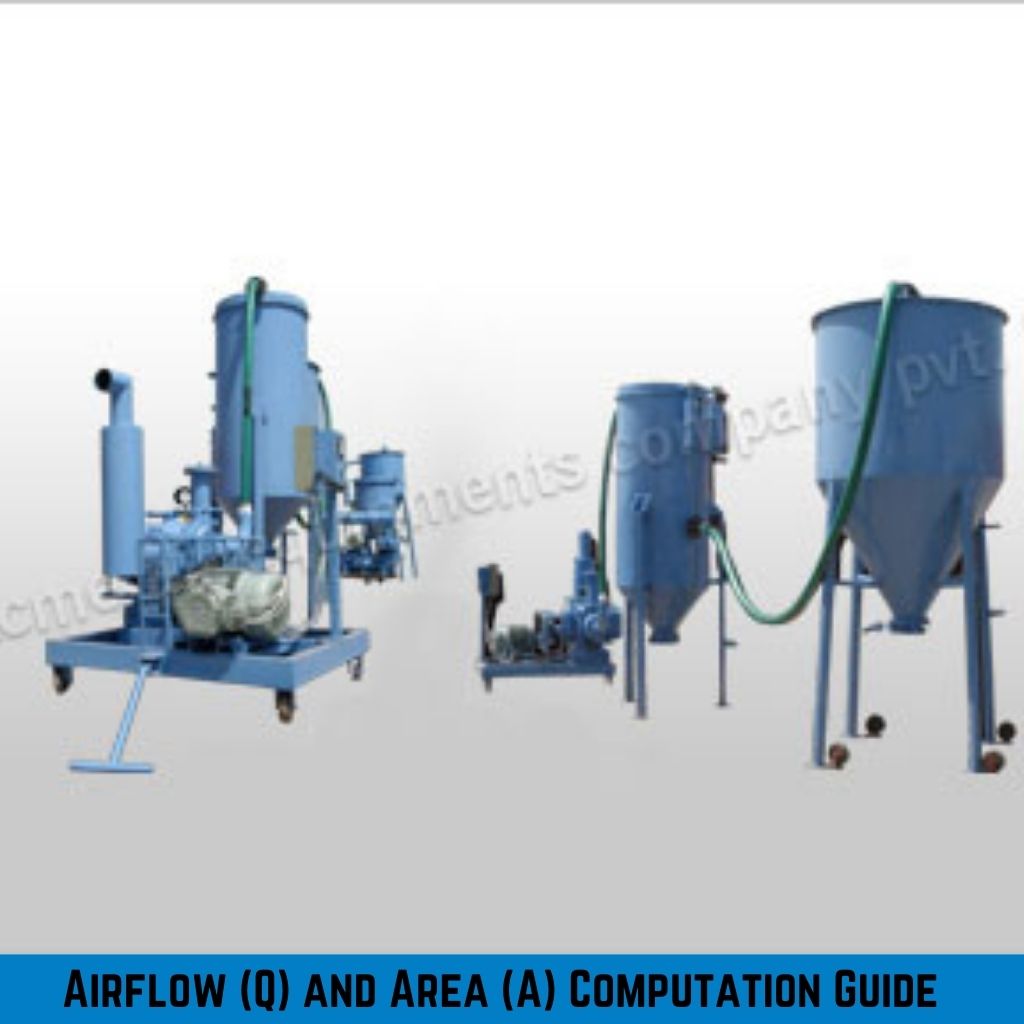Table of Contents
Pneumatic conveying systems are widely used to transport bulk materials, such as powders, granules, and pellets, through pipelines using air or other gases. For optimal performance, it’s essential to calculate air velocity and pressure drop accurately. These parameters directly affect the efficiency, energy consumption, and the overall performance of the conveying system. This article provides an illustrated formula breakdown for calculating air velocity and pressure drop in pneumatic conveying systems.
Objective of the Article:
The objective of this article is to:
- Provide a comprehensive explanation of how to calculate air velocity and pressure drop in pneumatic conveying systems, including step-by-step procedures and formulas.
- Illustrate the impact of air velocity and pressure drop on the overall performance of a pneumatic conveying system, including efficiency and energy consumption.
- Equip engineers and system designers with the knowledge to calculate and optimize system parameters to ensure smooth material flow, lower energy usage, and reduced operational costs.
- Offer insights into common factors affecting air velocity and pressure drop, including pipeline diameter, material properties, air density, and system design.
By the end of this article, readers will have a solid understanding of how to perform air velocity and pressure drop calculations for pneumatic conveying systems.
Step-by-Step Breakdown: How to Calculate Air Velocity and Pressure Drop in Pneumatic Conveying
Air Velocity Calculation in Pneumatic Conveying
Air velocity is a key parameter that determines how fast the air (or gas) moves through the conveying pipeline. It’s crucial for ensuring that the material is carried effectively through the system without causing blockages, degradation, or excessive wear.
Step 1.1: Basic Formula for Air Velocity
The general formula for calculating air velocity (V) in a pneumatic conveying system is:
V = Q/A
Where:
- (V) = Air velocity (ft/min or m/s)
- (Q) = Volumetric air flow rate (CFM or m³/h)
- (A) = Cross-sectional area of the pipe (ft² or m²)
Step 1.2: Airflow (Q) Calculation
To calculate air velocity, you first need to determine the airflow rate (Q). Airflow can be calculated using the following formula:
Q = Conveying capacity × Air-to-material ratio
Where:

- The conveying capacity is the amount of material being conveyed (measured in tons or kilograms per hour).
- The air-to-material ratio is a factor that varies depending on the type of material being conveyed and the specific system design. Typically, the air-to-material ratio ranges between 10:1 and 30:1 for most bulk materials.
Step 1.3: Calculate Cross-Sectional Area (A)
The cross-sectional area (A) of the pipeline can be calculated using the formula for the area of a circle:
Where:
- (A) = Cross-sectional area (ft² or m²)
- (D) = Inner diameter of the pipe (ft or m)
For example, if the pipeline has a diameter of 6 inches (0.1524 meters), the cross-sectional area (A) would be:
Now, with the airflow rate (Q) and the cross-sectional area (A), you can calculate the air velocity (V).
Pressure Drop Calculation in Pneumatic Conveying
Pressure drop is the reduction in air pressure as it moves through the conveying pipeline due to resistance from the pipe walls, bends, fittings, and the bulk material being conveyed. Excessive pressure drop can result in higher energy consumption, reduced material throughput, and system inefficiencies.
Step 2.1: Basic Formula for Pressure Drop
The most common formula used for calculating pressure drop (ΔP) in pneumatic conveying systems is:
ΔP=f×L×(V2/2gD)
Where:
ΔP = Pressure drop (Pa or in H₂O)
f = Friction factor (dimensionless, based on pipeline roughness and Reynolds number)
L = Length of the pipeline (m or ft)
V = Air velocity (m/s or ft/min)
g = Acceleration due to gravity (9.81 m/s²)
D = Diameter of the pipe (m or ft)
Step 2.2: Calculating Friction Factor (f)
The friction factor (f) depends on whether the flow is laminar or turbulent. It is typically determined using the Reynolds number (Re) and can be approximated using charts or empirical formulas:
- For laminar flow (Re < 2,000):
f=64Ref = \frac{64}{Re}f=Re64 - For turbulent flow (Re > 4,000):
The friction factor is typically determined using the Colebrook-White equation or approximated using empirical charts.
Step 2.3: Applying the Pressure Drop Formula
Once the friction factor (f) and other variables are known, substitute them into the pressure drop formula to calculate the pressure drop.
Example Calculation
Let’s consider an example:
- Conveying capacity: 5 tons per hour of material
- Air-to-material ratio: 20:1
- Pipe diameter: 6 inches (0.1524 meters)
- Pipeline length: 100 feet (30.48 meters)
- Airflow rate: 1000 CFM
- Air velocity (V): 30 ft/min
Step 3.1: Calculate Cross-Sectional Area (A)
A = π (0.1524 / 2)2 = 0.0182 m2
Step 3.2: Airflow Calculation
Q = 5 tons/hour × 20 = 100 CFM
Step 3.3: Air Velocity Calculation
Using the formula:
V = Q / A = 1000 CFM / 0.0182 m2 = 55,000 ft/min
Step 3.4: Pressure Drop Calculation
Using the formula and the appropriate friction factor for turbulent flow, calculate the pressure drop in the system. For simplicity, this can be done with appropriate software tools or charts based on the given pipe length, diameter, and air velocity.
FAQs:
Why is air velocity important in pneumatic conveying systems?
Air velocity determines how efficiently materials are transported through the system. Insufficient air velocity can lead to blockages or poor material flow, while excessive velocity can cause damage to the material or increase system wear.
What factors influence pressure drop in pneumatic conveying?
The main factors influencing pressure drop include pipe diameter, material characteristics, airflow velocity, pipe length, and system fittings such as elbows and valves. The roughness of the pipe surface also plays a role in friction.
How do I calculate the correct pipe diameter for my system?
To calculate the optimal pipe diameter, you need to balance air velocity and material handling capacity. The diameter must be large enough to handle the required airflow (CFM) without causing excessive pressure drop or air turbulence.
What happens if the pressure drop is too high?
If the pressure drop is too high, it can reduce the efficiency of the system, requiring more energy to maintain the required airflow. It can also cause material blockages, wear on the components, and decreased system reliability.
How can I minimize pressure drop in pneumatic conveying systems?
<p>To minimize pressure drop, you can:</p>
<ul>
<li>Use <strong>larger diameter pipes</strong> to reduce air velocity.</li>
<li>Reduce the number of <strong>bends and fittings</strong> in the ductwork.</li>
<li>Optimize <strong>airflow</strong> to match the material characteristics and pipeline design.</li>
</ul>
Can I calculate air velocity and pressure drop using software?
Yes, specialized pneumatic conveying software and online calculators can help you easily calculate air velocity, pressure drop, and other parameters by simply inputting system specifications such as pipe diameter, material type, and airflow.
Conclusion
Calculating air velocity and pressure drop is crucial for optimizing the performance of pneumatic conveying systems. By using the formulas and methods outlined in this guide, engineers can design systems that efficiently convey materials, reduce energy consumption, and improve overall system longevity. Accurate calculations ensure that the system is well-balanced, allowing for safe, efficient operation and cost-effective performance.
About Author

CEO
Mr. Vishwesh Pardeshi is the CEO of Acme Air Equipments Company Pvt. Ltd., an industrial and engineering goods manufacturing company based in Ahmedabad, Gujarat (India). He has taken over the responsibility from founding Partners and Directors of the Company, and is now leading a talented group of professionals since 2020 by bringing in vast industrial and management expertise. By qualification, he holds a Bachelor Degree in Mechanical Engineering and also holds a MBA degree from reputed institutes. Under his leadership, the Company has successfully executed prestigious projects by delivering high quality and world class products from a state of the art manufacturing facility which combines CNC-enabled precision manufacturing and strong after sales support. In line with the Vision, Mission and Core Values of the Organization, Mr. Vishwesh Pardeshi continues to drive Quality, Reliability and Global Expansion at Acme Air Equipments Co. Pvt. Ltd.









